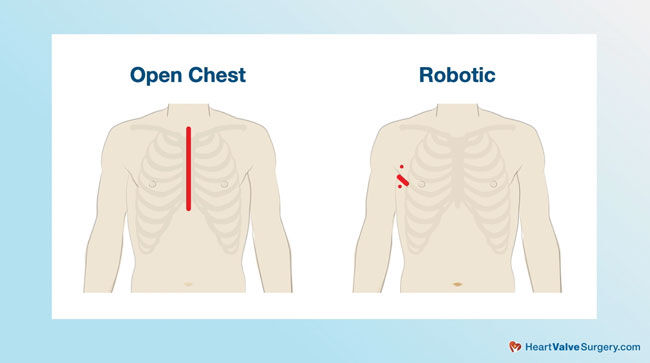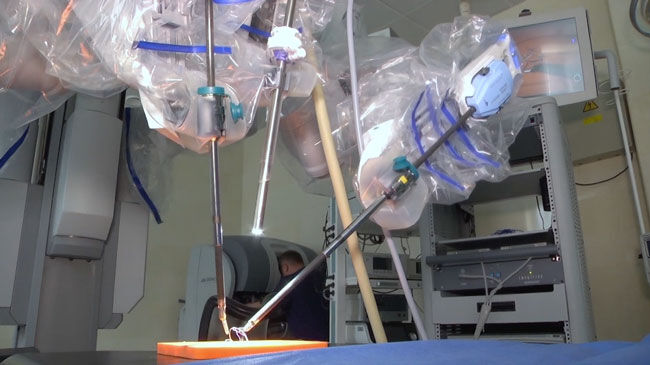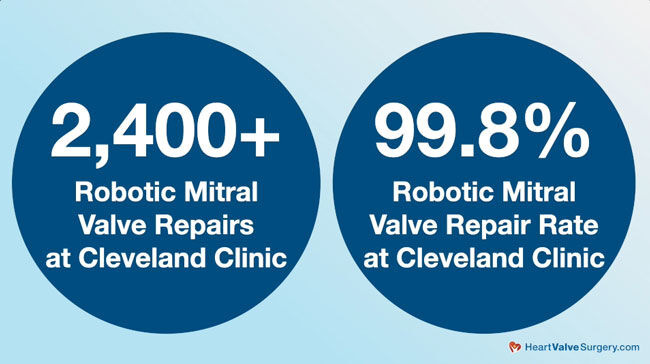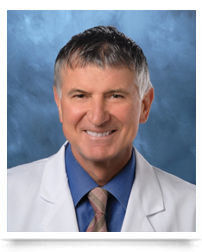Surgeon Roundtable: Top 5 Questions To Ask Your Robotic Mitral Valve Surgeon
Written By: Allison DeMajistre, BSN, RN, CCRN
Medical Experts: Marc Gillinov, MD, Chief of Cardiac Surgery, Tarek Malas, MD, Cardiac Surgeon, Cleveland Clinic
Reviewed By: Adam Pick, Patient Advocate, Author & Website Founder
Published: September 18, 2024
Robotic mitral valve repair is a minimally-invasive procedure requiring only very small incisions that provides patients several advantages including less pain and faster recovery times. However, the idea of robotic mitral valve surgery should not lead patients to an immediate conclusion that it is less complex than a traditional open-chest procedure. Robotic mitral valve surgery is a highly technical and intricate operation that should be limited to specialized centers and skilled surgeons.
To help patients learn more about robot-assisted mitral valve repair, we sat down with two of Cleveland Clinic’s most experienced robotic surgeons. Dr. Marc Gillinov, Chief of Cardiac Surgery, and Dr. Tarek Malas, Staff Cardiac Surgeon, and their team at Cleveland Clinic have performed over 2,000 robotic mitral valve surgeries. Specifically, we wanted to know what Dr. Gillinov and Dr. Malas considered to be the “Top 5 Questions” patients should ask their surgeons before having a robotic mitral valve operation.
Top 5 Questions Patients Need To Ask
According to Dr. Gillinov and Dr. Malas, here are the top five questions to ask your robotic mitral valve surgeon:
Question #1: Is robotic surgery better for me than regular heart surgery through a sternotomy?
According to Dr. Gillinov, most often, the answer is yes. “Robotic surgery is better for you because, with small incisions, you’re going to recover more quickly, you won’t look like you had heart surgery, and you’re going to feel better much faster than you would if you had a standard sternal incision,” Dr. Gillinov said. “Why? Because in the robotic operation, we go through the side with small incisions, and we do not cut any bones.”

Question #2: Am I a candidate for robotic surgery?
Dr. Malas said, “That’s a question we examine together in a multidisciplinary team, meaning we work together with cardiologists, anesthesiologists, etc., to evaluate whether you are a candidate. And we do a CT scan and certain testing procedures to evaluate if you are a candidate.”
Question #3: Can you do the same thing with the robot as you would through a regular incision?
Dr. Gillinov explained that this question helps patients determine that a surgeon won’t cut corners and perform a lesser operation just so that a patient can get a smaller incision. He said, “We are selective and have great expertise after more than 2,000 robotic operations, such that we know we can do exactly the same thing through a small incision to speed the recovery. So the answer has to be, ‘Yes!’ The surgeon can do the same thing with the small robotic incisions as through a sternotomy.”

Robotic Arms
Question #4: How do you choose your heart surgeon?
According to Dr. Malas, it’s important to go to a center with extensive expertise and volume and with surgeons who have performed robotic mitral valve repair many times. “As you know, robotic surgery is not taught in medical school. This takes a lot of expertise and time to develop. It’s important to go to a center that has done quite a lot, like the Cleveland Clinic. We’ve done more than 2,400 cases, and we have done them very well with a repair rate of about 99.8%,” said Dr. Malas. “We’ve mastered the learning curve here to make it a routine surgery, and we’ve worked together effectively as a team and performed the surgery in a fantastic, very structured way.”
 Cleveland Clinic Outcomes for Mitral Valve Repair Surgery
Cleveland Clinic Outcomes for Mitral Valve Repair Surgery
Question #5: How does the robot work?
“Many people think it’s sort of like a Keurig coffee maker where you hit a button, you come back, and the coffee is made,” said Dr. Gillinov. “Unfortunately, for the surgeon, it’s not like that. There’s no button that makes the robot repair your mitral valve or close an atrial septal defect.” Dr. Gillinov said the robot is a highly advanced, resilient tool used most commonly to repair the mitral valve. “The most important part of it is a camera because we put it into the chest,” he said.
“We don’t need an incision or a hole as big as my hand because my hand never goes into the chest,” Dr. Gillinov said. “The camera is a three-dimensional camera, which enables the surgeon, Dr. Malas, or myself, sitting at a console, to see inside your heart with three-dimensional visualization. Then, we can use three instruments at once.”
Dr. Gillinov continued, “The instruments are on long tubes, a little bit thicker than a straw, and they go into the chest, and although we only have two hands, we can have three instruments and a camera operating at once with us controlling them from the console. We then use these instruments, which are scissors and forceps, just like regular instruments. We use them to repair your valve, and with the excellent camera and these very flexible instruments, we can do everything through tiny incisions such that the day after surgery, you don’t look like you had heart surgery.”
Thanks Dr. Gillinov, Dr. Malas and the Cleveland Clinic!
On behalf of the HeartValveSurgery.com patient community, thank you, Dr. Gillinov and Dr. Malas, for giving us these five important questions to ask when searching for an experienced surgeon and to learn more about robotic mitral valve repair. We would also like to thank the Cleveland Clinic for continuing to care for heart valve patients and keep them informed!
- Patient Success Story: Ginny, Lisa and Randy Celebrate Dr. Marc Gillinov
- Educational Patient Webinar: 3 Questions to Ask Before Mitral Valve Surgery
- Surgeon Insights: Top 3 Facts to Dispel Patient Anxiety Before Heart Surgery
Keep on tickin!
Adam
P.S. For the deaf and hard-of-hearing members of our community, I have provided a written transcript of this surgeon roundtable video below.
References:
1. Williams ML, Hwang B, Huang L, et al. Robotic versus conventional sternotomy mitral valve surgery: a systematic review and meta-analysis. Ann Cardiothorac Surg. 2022;11(5):490-503. doi:10.21037/acs-2022-rmvs-21
Video Transcript:
Dr. Marc Gillinov: I’m Mark Gillinov, the Chairman of Cardiac Surgery at the Cleveland Clinic.
Dr. Tarek Malas: And I’m Tarek Malas, I’m a cardiac surgeon here at the Cleveland Clinic.
Dr. Marc Gillinov: Together, we are the key components of the robotic team. We both do robotic heart surgery. And if you are contemplating robotic heart surgery, there are five key questions that you should consider and that you should ask. The first question is this, “Is robotic surgery better for me than regular heart surgery through a sternotomy?”
And most often the answer is yes, robotic surgery is better for you because with small incisions you’re going to recover more quickly, you won’t look like you had heart surgery, and you’re going to feel better much faster than you would if you had a standard sternal incision.
Why? Because in the robotic operation, we go through the side with small incisions and we do not cut any bones.
Dr. Tarek Malas: The second question in robotic surgery to ask is, “Am I a candidate for robotic surgery.” That’s a question that we examine together in a multidisciplinary team, meaning we work together with cardiologists, anesthesiologists, etc., to evaluate whether you are a candidate. And we do a CT scan and certain testing procedures to evaluate if you are a candidate.
Dr. Marc Gillinov: The third question you should ask your surgeon concerning robotic heart surgery is this, “Can you do the same thing with the robot as you would through a regular incision?”
Meaning you don’t want somebody to cut corners and give you a lesser operation just so you can get a smaller incision. We are selective and we have great expertise after more than 2,000 robotic operations, such that we know when we can do exactly the same thing through a small incision to speed the recovery.
So the answer has to be “Yes”. The surgeon can do the same thing with the small robotic incisions as through a sternotomy.
Dr. Tarek Malas: The next important question to ask is, “How do you choose your heart surgeon?”
It’s important to go to a center that has a lot of expertise and a lot of volume. Surgeons who have performed this procedure many times.
As you know, robotic surgery is not something that is taught at medical school. This takes a lot of expertise and time to develop. It’s important to go to a center that has done quite a lot, like the Cleveland Clinic. We’ve done more than 2,400 cases and we have done them very well with a repair rate of about 99.8%.
We’ve mastered the learning curve here to make the surgery a routine surgery and we’ve worked together effectively as a team and performed the surgery in a fantastic, very structured way.
Dr. Marc Gillinov: The final question is really one just of curiosity, “How does the robot work?” Many people think it’s sort of like a Keurig coffee maker where you hit a button, you come back and the coffee is made.
Unfortunately, for the surgeon, it’s not like that. There’s no button that makes the robot repair your mitral valve or close atrial septal defect. And it is used most commonly repair the mitral valve and it is a tool. It’s an extremely advanced, resilient tool. The most important part of it is a camera because we put a camera into the chest.
We don’t need a, incision or a hole as big as my hand. Cause my hand never goes in the chest. The camera is a three-dimensional camera, which enables the surgeon,
Dr. Malas or myself, sitting at a console to see inside your heart with three dimensional visualization. Then we can use three instruments at once.
The instruments are on long tubes, a little bit thicker than a straw, and they go into the chest, And although we only have two hands, we can have three instruments and a camera operating at once, us controlling them from the console. And then we use these instruments, which are scissors and forceps, just like regular instruments. We use them to repair your valve, and with the excellent camera and these very flexible instruments, we can do everything through tiny incisions, such that the day after surgery, you don’t look like you had heart surgery.




